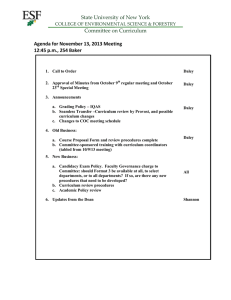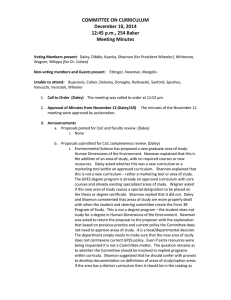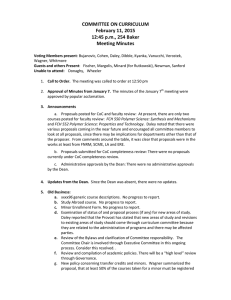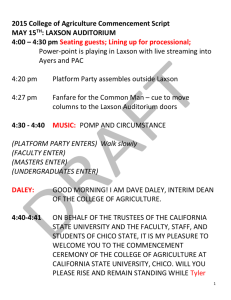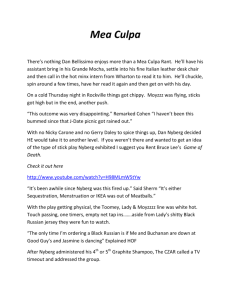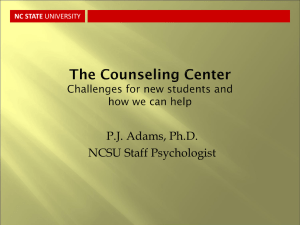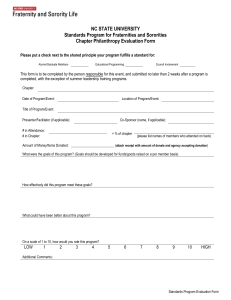PA 531 - Human Resource Management in Public and Nonprofit
advertisement
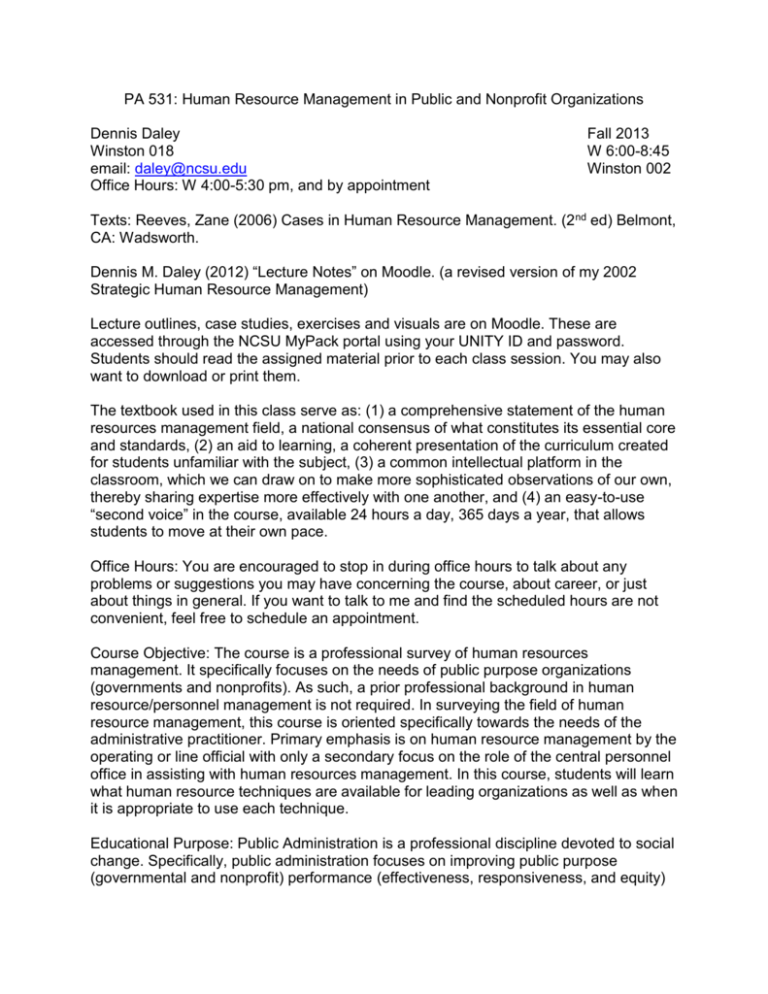
PA 531: Human Resource Management in Public and Nonprofit Organizations Dennis Daley Winston 018 email: daley@ncsu.edu Office Hours: W 4:00-5:30 pm, and by appointment Fall 2013 W 6:00-8:45 Winston 002 Texts: Reeves, Zane (2006) Cases in Human Resource Management. (2 nd ed) Belmont, CA: Wadsworth. Dennis M. Daley (2012) “Lecture Notes” on Moodle. (a revised version of my 2002 Strategic Human Resource Management) Lecture outlines, case studies, exercises and visuals are on Moodle. These are accessed through the NCSU MyPack portal using your UNITY ID and password. Students should read the assigned material prior to each class session. You may also want to download or print them. The textbook used in this class serve as: (1) a comprehensive statement of the human resources management field, a national consensus of what constitutes its essential core and standards, (2) an aid to learning, a coherent presentation of the curriculum created for students unfamiliar with the subject, (3) a common intellectual platform in the classroom, which we can draw on to make more sophisticated observations of our own, thereby sharing expertise more effectively with one another, and (4) an easy-to-use “second voice” in the course, available 24 hours a day, 365 days a year, that allows students to move at their own pace. Office Hours: You are encouraged to stop in during office hours to talk about any problems or suggestions you may have concerning the course, about career, or just about things in general. If you want to talk to me and find the scheduled hours are not convenient, feel free to schedule an appointment. Course Objective: The course is a professional survey of human resources management. It specifically focuses on the needs of public purpose organizations (governments and nonprofits). As such, a prior professional background in human resource/personnel management is not required. In surveying the field of human resource management, this course is oriented specifically towards the needs of the administrative practitioner. Primary emphasis is on human resource management by the operating or line official with only a secondary focus on the role of the central personnel office in assisting with human resources management. In this course, students will learn what human resource techniques are available for leading organizations as well as when it is appropriate to use each technique. Educational Purpose: Public Administration is a professional discipline devoted to social change. Specifically, public administration focuses on improving public purpose (governmental and nonprofit) performance (effectiveness, responsiveness, and equity) through the application of professional management education and techniques. The course content is designed both to develop an individuals’ ability to think effectively (i.e., observing, classifying, analyzing, and synthesizing) and to introduce them to state-of-the-art administrative knowledge and competencies. This knowledge and related competencies are transferable to other situations and should aid the student in developing intellectual autonomy. In addition, both the enhanced critical-thinking abilities and specific managerial knowledge and competencies should be of direct benefit to students on their jobs and in the development of their careers. Course Format: Course material uses an action-learning format of simulations/case studies and complementary discussions-lectures. Class participation is encouraged. This fosters a peer-learning environment designed to integrate the substantive context of teach topic with the subjective context in which it is performed. Students are to have prepared prior to each class by reading the appropriate assignments and reviewing the scheduled exercises. While students should attend every class, they are not required to participate every time. Participation is judged on attendance, on the ability to express oneself clearly, and on the originality and insightfulness of the contributions. Each section focuses on a set of related topics analyzed in terms of why you would want to use them, how you would use them, and what are the problems you might encounter in using them. Each Human Resource function is compared across the continuum of public, nonprofit, and private organizations. While primarily focused on the management techniques used in human resources, the legal aspect inherent in each function is also examined. Grading: Grades are based on the total scores derived from two exams (100 points), participation (20 points), case study/exercise memos (30 points), and a research paper (50 points). A+ A AB+ B BC+ C CD+ D DF 200-194 193-186 185-180 179-174 173-166 165-160 159-154 153-146 145-140 139-134 133-126 125-120 119-0 Exams (50 points): There are a Midterm and a Final exam. Each exam is worth 50 points and consists of two questions that may be either essays and/or applied question. Tests are meant to accomplish two purposes. They permit the evaluation of a student’s academic performance thus giving essential feedback to the student, as well as to those who have a need to judge the student’s ability. In addition, they direct student energy into areas considered appropriate by the instructor. Administration focuses on understanding and balancing the details necessary for the implementation of policy. Talent alone does not suffice; governing requires a mastery of detail upon which to apply one’s critical thinking. The keys to outstanding essay answers are (1) well-written essays that directly address all of the questions posed, (2) a demonstrated student understanding/discussion of the course material, and (3) insight/analysis into the implications of that material. Each exam question is assessed against a set of standards divided into component parts weighted to their perceived overall importance to the question. In essence, each component is evaluated as (0) Null [Nothing or Clueless], (1) Unaware [Poor or Vague], (2) Aware [Fine or Registers], (3) Proficient [Good or Knows], and (4) Advanced [Excellent or Understands]. The more general discuss and analysis questions focus primarily on assessing an awareness of concepts and their component parts. The more specific compare and contrast questions focus on a narrower topic and place greater emphasis upon demonstrating proficiency. Case Study/Exercise Memos (30 points): using the case study/exercise guidelines, each student is responsible for a 2 page, single-spaced memo on six (6) of the case studies/exercises (5 points each). Each memo is due the week following the in-class discussion. A case study is a word problem while an exercise focuses on action learning. A case study poses an interactive problem that links facts and theories to a specific situation in which they are applied. First, diagnose what the specific problem is. There may also be secondary problems (case study questions may point to these). Second, determine what are the options (recommended procedures, practices, and techniques) for dealing with or solving the problem (the main textbook should help in identifying these). Third, identify what special considerations must be taken into account. Who are the stakeholders, and what roles do they play? What assumptions or attributions are you making about the problem and the circumstances under which it occurs? Fourth, make a recommendation or decision (case study questions may act as prompts). These decisions need to be provided with supporting evidence that explains or justifies why the decision was made. Fifth, the student should focus on assessment and analysis of the case study or simulation reflecting on the lessons and insights were derived from it. Research Paper (50 points): A research paper is required; it is worth 50 points. It should be article length (15-20 typed double-spaced pages) and focus on some aspect of human resource management/personnel administration. Each student shall meet with the instructor at the beginning of the course to agree upon a research topic. A one-page prospectus outlining the research project, including a research design and preliminary list of sources, is due at the third class. Experiments/Lab Studies, Case/Field Studies, and Empirical/Statistical Studies are expected. The student is expected to take an aspect or topic in the “theoretic” material presented in the texts and literature and conduct an original “test” of it against our reality. In beginning research on a topic, students should look for articles labeled as literature reviews, bibliographic essays, or meta-analyses. A topical examination of these over the past five to ten years should prove sufficient The literature review aspect of the paper analyzes recent developments that affect human resource management functions (e.g., job analysis, recruitment & selection, productivity, performance appraisal, training & development) or recent developments in ongoing controversies (e.g., pay-for-performance, health care, managing diversity, contracting-out, volunteers, and board of director relationships). Although discussion can be drawn from the business or general management literature, the paper must emphasize the public or nonprofit agency in whatever topic is covered. While practitioner sources can be included, the literature review must include sufficient academic sources. An analysis of the strengths and weaknesses pointed out by the literature should be included followed by a synthesis drawn from the literature review serves as the theoretic framework for the paper. The next step is outlining a research design for testing this theory. This may be quantitative or qualitative, employing statistical, comparative, or case analysis. Quantitative or empirical analysis can be based on existing datasets or original data collection (NC State University/Public Administration has a number of datasets available for general use). Qualitative research focusing on a specific HR practice would use comparisons of 2--3 different organizations or an in-depth case study of one organization focusing on staff, supervisor, and employee perceptions (involving 6-9 individual interviews in each case). The original research aspect of the paper begins with a description of the specific organization(s) and analyzes it in terms of the research topic. The organization is compared and contrasted with what the research literature describes or prescribes. In drawing conclusions or lessons from the research literature, it is important to provide some documentation as the foundation of this analysis. Research papers are assessed: Topic relevance to personnel/human resource management (5 points) Style and grammar proficiency (5 points) Methodology appropriate to answering theoretic question (5 points) Sources adequate to establish understanding of problem area (5 points) Description of theory/problem area (10 points) and case study/empirical test (5 points) Analysis of theory/problems logic (10 points) and case study/empirical test (5 points) Human Resource Management Course Outline Aug 21: History/Context (Daley 1, 2; Heavy Lifting) Position Classification: Aug 28: Job Analysis Discussion (Daley 4, 5; Smoky Bear is an Underfill) Sep 4: Job Evaluation Discussion (Daley 6; Job Evaluation Exercise) Staffing: Sep 11: Recruitment and Retention (Daley 7; Recruitment of a Water Plant Technician; Sunny Skies Hiring) Sep 18: Selection (Daley 8; Hiring Exercise; Tom Collins) Sep 25, Oct 2: Compensation (Daley 9, 10; SAS DVD; Paying Tucson Police, Salary Compression at State U) Oct 9: Midterm Performance Management: Oct 16, 23: Performance Appraisal (Daley 11, 12; Performance Appraisal Exercise; Merit Pay) Oct 30: Training and Development (Daley 13; Fearless Freddy) Nov 6: Strategic Management (Daley 3; Cutback Exercise) Employee Relations: Nov 13, 20: Grievance and Discipline (Daley 14, 15; Culture Clash, Missing Portable Potty); Mediation (Daley 8. Mediation DVD, Mediation Rockin Roleplays) Nov 20, Dec 4: Labor Relations & Negotiations (Daley 16, 17; Negotiation DVD) Dec 4: Collective Bargaining Exercise Dec 4: Final Paper due. Dec 11: FINAL 6-9pm Instructor: Dennis M. Daley received B.A.’s in History and Government from Montana State University, an M.A. in Political Science from the University of Montana, and his Ph.D. in Political Science from Washington State University. He has taught on the faculty of Minnesota State University (Mankato), Iowa State University, the University of Mississippi, and North Carolina State University. He is the author of Strategic Human Resource Management and Performance Appraisal in the Public Sector. He has authored over two score articles in refereed public administration journals, including the leading public sector personnel journals Public Personnel Management and the Review of Public Personnel Administration. He is a member of the Academy of Management Personnel/Human Resources Division, International Personnel Management Association, and the American Society for Public Administration Section on Personnel and Labor Relations. Academic Integrity: In this, as in all classes at North Carolina State, students are expected to complete their assignments with due regard to academic integrity. In order to do so, they should familiarize themselves with the relevant section of the Students Code of Conduct (Section 7-13). By signing all work submitted on a paper, or by identifying themselves in work submitted electronically, students affirm that they neither gave nor received unauthorized aid. In particular, collaboration on assignments among students may only occur when explicitly authorized by an instructor. Attendance: I expect every student to be here on time, fully prepared having read all assigned materials, every day that the student is scheduled for class. I expect every student to strive for perfect attendance. Disabilities: Whenever possible, modifications to tests and other assignments and special arrangements for attending and recording lectures and seminars will be made in order to accommodate the needs of students with disabilities. Any student with such a need is encouraged to make an appointment with the instructor in order to obtain necessary assistance. Course Evaluation: Schedule: Online class evaluations will be available for students to complete during the last week of class. Students will receive an email message directing them to a website where they can login using their Unity ID and complete evaluations. All evaluations are confidential; instructors will never know how any one student responded to any question, and students will never know the ratings for any particular instructors. Evaluation website: https://classeval.ncsu.edu Student help desk: classeval@ncsu.edu More information about ClassEval: http://www2.acs.ncsu.edu/UPA/classeval/ Work-Family: A concerted effort will be made to balance work and family considerations in as much as this can be done without sacrifice to the course’s educational integrity. Other recommended Human Resource courses include: PA 532: Contract Negotiations, Drafting, and Mediation PA 535: Problem Solving for Public Managers EAC 582: Organization and Operation of Training and Development Programs EAC 586: Methods and Techniques of Training and Development PSY 751: Human Resource Planning PSY 766: Personnel Selection Research PSY 767: Training Research PSY769: Work Motivation CHASS CAREER SERVICES: Explore career options related to your major, make decisions about your major or minor, build resumes and cover letters, prepare for interviews, develop internship/ job search strategies, maximize career fairs, and more. Use ePACK to make an appointment with your career counselor -- Jane Matthews or Woody Catoe -- through ePACK. Career Development Center, 2100 Pullen Hall. careers.ncsu.edu
